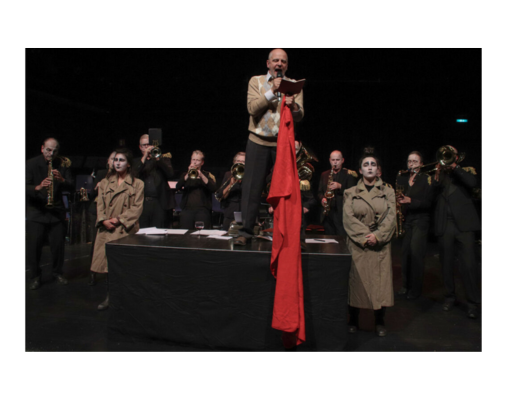Veranstaltungen

- Diese Veranstaltung hat bereits stattgefunden.
Unerhört 136
27. Mai um 20:00 bis 22:30

Die Bremer Blasskapelle Lauter Blech organisiert dieses Jubiläumskonzert und verbindet die Musik ihres Lieblingskomponisten mit einer theatralischen Inszenierung (in Kooperation mit der Shakespeare Company Bremen) und Livemusik zu dem dadaistischen Stummfilm “Entr’acte” (1924) von René Clair und Francis Picabia
Tickets: 18/12 €
Vorbestellung info@unerhoert.net
Eine der legendären Figuren der Pariser Montmatre Szene um 1900 mit ihren modernen Kunstansätzen, mit ihren Cabarets und ihrer frivolen Unterwelt tritt auf. Monsieur Satie, Zeitgenosse von Toulouse Lautrec, Picasso, Jean Cocteau ist selbst eine schillernde Figur, ein kautziger Grenzgänger zwischen Musik, Literatur und Religion.
Die Filmusiken französischer Filme bedienen sich häufig einfacher Kopien seiner „endlich einfachen“ Musiken wie den Gymnopedien. Die Filmmusiken zu René Clairs surrealistischem Kurzfilm Entr‘acte (1924) gilt für viele Komponisten der Minimal Music der 1980 Jahre als Initialzündung. Und John Cage, umstrittene amerikansiche Lichtgestalt der Neuen Musik sieht Erik Satie als wahren Begründer der Avantgarde Musik im 20. Jahrhundert.
Und Erik Satie selbst? Wandelt mal ironisch mal selbstzerstörerisch zwischen Absynth und selbstgegründetem katholischen Orden, zwischen Nachtleben mit Chanson Kompositionen, Musiken für „Sport und Unterhaltung“, möbelierten Inneneinrichtungen, Quälereien und bürokratischen Sonatinen, die die damalige Musikwelt bisweilen empörte.
„SATIESfaktionen“ ist eine musikalisch-literarische Hommage an Erik Satie anlässlich seines 100. Todestages. Anlass für die Bremer Blaskapelle Lauter Blech, einem ihrer Lieblingskomponisten einen ganzen Abend zu widmen und das nicht nur mit Musik.
Kaleidoskopisch und bühnenwirksam nimmt sich die 14 köpfige Brass Band der Satieschen Kompositionen an – immer versehen mit dem Hang zu musikalischen Stolpersteinen. Zu Ausschnitten aus René Clairs surrealistischem Kurzfilm Entr‘acte (1924) wird Saties kongeniale Filmmusik live gespielt.
In einer Inszenierung von Frank Bobran präsentieren Michael Meyer, Meike Lehmann und Matthias Guggenberger Leben und Werk Saties als fragmentarische „Lebenspartitur“, eingebettet in seine humorvollen Texte. Die drei Darsteller:innen verkörpern assoziativ verschiedene Facetten Saties:
Sie „oszillieren“, wie es in einer Selbstbeschreibung Saties heißt.
Karten Abendkasse 18/12 EUR – Reservierung per Email: info@unerhoert.net
In Zusammenarbeit mit der Arbeitnehmerkammer Bremen
Lauter Blech in Aktion mit Michael Meyer (Bremer Shakespeare Company):


